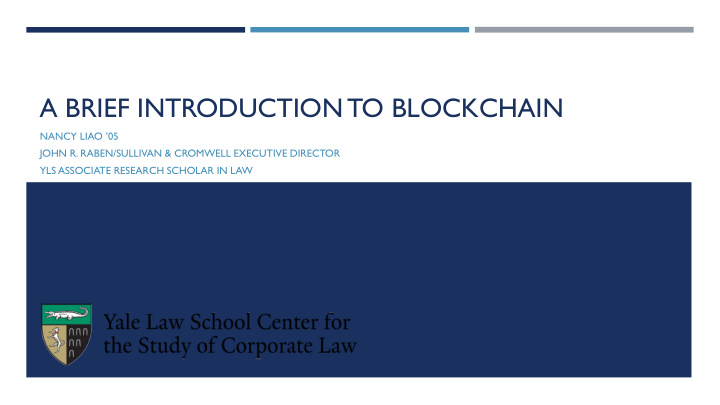



A BRIEF INTRODUCTION TO BLOCKCHAIN NANCY LIAO ’05 JOHN R. RABEN/SULLIVAN & CROMWELL EXECUTIVE DIRECTOR YLS ASSOCIATE RESEARCH SCHOLAR IN LAW
“BLOCKCHAIN” HAS MANY MEANINGS “To understand the power of blockchain systems, and the things they can do, it is important to distinguish between three things that are commonly muddled up, namely the bitcoin currency, the specific blockchain that underpins it and the idea of blockchains in general.” The Trust Machine , T HE E CONOMIST , Oct. 31, 2015
“BLOCKCHAIN” HAS MANY MEANINGS Phone Blockchain • The idea of • The idea of a blockchain phone network • The specific • A specific phone blockchain that network ( e.g. , underlies Bitcoin AT&T) or another coin • A specific use of offering the phone network • Bitcoin or another ( e.g. , fax) cryptocurrency
WHAT IS BLOCKCHAIN? A technology that: permits transactions to be gathered into blocks and recorded; cryptographically chains blocks in chronological order; and allows the resulting ledger to be accessed by different servers.
WHAT IS A DISTRIBUTED LEDGER? Centralized Ledger Distributed Ledger Client A Node A Node E Node B Bank Client Client B C Node D Node C Client D There are multiple ledgers, but Bank holds the “golden record” There is one ledger. All Nodes have some level of access to that • • Client B must reconcile its own ledger against that of Bank, and ledger. • must convince Bank of the “true state” of the Bank ledger if All Nodes agree to a protocol that determines the “true state” of • discrepancies arise the ledger at any point in time. The application of this protocol is sometimes called “achieving consensus.”
WHAT IS A DISTRIBUTED LEDGER? Single Entity Multiple Entities
HOW MIGHT A DISTRIBUTED LEDGER WORK? Users initiate Users Broadcast One or more Nodes aggregate transactions their Nodes begin validated using their Digital transactions to validating each transactions into Signatures Nodes transaction Blocks Nodes Broadcast Consensus Block reflecting Blocks to each protocol used “true state” is other chained to prior Block
WHERE MIGHT BLOCKCHAIN USE CRYPTOGRAPHY? Initiation and Broadcasting • Digital Signatures of Transaction • Private/Public Keys Validation of Transaction • Proof of Work and certain alternatives Chaining Blocks • Hash Function
THE POWER OF DISTRIBUTED LEDGERS It can be used to It can be used to allow record those owners of assets to It can be used to transfers of value or exercise certain rights It can be used without a central transfer value or the It can be used to ownership of assets associated with BLOCKCHAIN authority by individuals or ownership of assets create value or issue ownership, and to entities with no basis to trust • These records may be assets • A human being or a record the exercise of each other very difficult to alter, Smart Contract can such that they are those rights. initiate the transfer sometimes called • Proxy Voting effectively immutable The degree of trust between users determines the technological configuration of a distributed ledger.
HOW MIGHT DISTRIBUTED LEDGER PROPOSALS DIFFER? Participation Open Closed Permission Permissionless Permissioned Ledger Design One ledger One ledger or Segregated ledgers Validation Methodology depends on degree of trust between nodes. Where there is no basis for trust, may be achieved through proof of work, which requires the algorithmic solving of a cryptographic hash. Consensus Mechanism Mechanism depends on degree of trust between nodes. Where there is no centralized authority, consensus may be determined algorithmically.
QUESTIONS? Nancy Liao nancy.liao@yale.edu
Recommend
More recommend